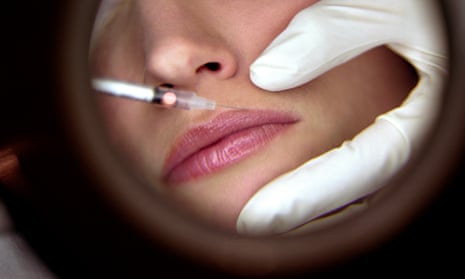Sales for Botox – the drug that erases wrinkles and treats muscular disorders – reached nearly $2bn last year. The treatment is generally considered safe and doctors use it liberally, in part because of the view that it’s a relatively harmless and temporary solution to ailments real and imagined.
But a recent study from the University of Wisconsin-Madison has raised fresh doubts about how Botox works in the body. Contrary to notions that it stays put at the injection site, researchers found evidence from animal tests that the drug was in fact able to move between nerve cells, raising the possibility that the same kind of migration could be occurring in humans.
This isn’t a new concern. The US Food and Drug Administration (FDA) added a safety warning in 2009 that said the toxin “may spread from the area of injection to produce symptoms of botulism”, including muscle weakness and difficulty breathing that can occur hours or weeks after an injection.
Botox is the trade name for Botulinum Toxin Type A, a neurotoxin known for causing botulism, an illness that paralyzes muscles and can be fatal. Botox first got FDA approval to treat medical ailments such as muscle spasms, excessive underarm sweating and eyelid tics.
In 2002, the FDA approved the drug to be used cosmetically to minimize facial wrinkles, primarily the vertical lines between the eyebrows. Botox had been used off-label for cosmetic purposes prior to this.
In 2001, Botox sales were just a little over $300m; last year, sales reached $1.9bn and accounted for nearly half of manufacturer Allergan’s overall revenue.
Botox has a remarkably safe history. Only 36 serious adverse effects associated with cosmetic use were reported to the FDA between 1989 and 2003, according to a 2005 study. And of those, 13 patients had underlying medical conditions that may have explained their response to the drug.
“Any medication has risks, but the safety record for Botox is actually very robust,” said Hayley Goldbach, a resident physician of dermatology at the University of California-Los Angeles Health. “And consider that there have been tens of millions of patients treated with Botox.”
The Wisconsin study set out to test whether the toxin remains in the injected area, or whether it has the ability to travel. The researchers looked at two strains of botulinum toxin. Using mouse neurons, they showed that the toxin molecules were able to move between different nerve cells in a lab dish.
“Once these toxins enter a neuron, a fraction of the toxin acts within that neuron, but another fraction is able to move – from the first neuron – into connected neurons,” said senior author Edwin Chapman, an investigator at the Howard Hughes Medical Institute and professor of neuroscience at the University of Wisconsin-Madison. “In other words, these toxins do in fact move about among connected networks of neurons.”
What isn’t clear is how far the toxin travels, said Chapman, which could depend on the dose and other factors.
But doctors say they’re still mostly comfortable with Botox procedures. Even if the toxin is able to move between nerve cells, it’s unlikely that it will result in complications far from the injected site, said Kathleen Souzzi, an instructor at the department of dermatology at the Yale School of Medicine. For instance, a person likely won’t experience trouble breathing after being injected with Botox in the face.
“Complications are rare and when they occur typically involve the local spread of the toxin to cause paralysis of unintended targets, for example, eyelid drooping,” she said.
The study tested mice neurons using a test tube, and it’s not clear whether the same results would occur in a living organism like the human body, said Goldbach.
“They didn’t study humans so their findings can’t necessarily be extrapolated beyond the laboratory,” she said. “Also, even if there is some migration, we need to know how far and if it is important or dangerous.”
Chapman concedes that more research is needed to see how the drug interacts with human nerve cells.
“That’s a valid question,” he said. “Now we know for certain that the toxins can move from neuron to neuron, that’s the beginning, not the end.”
For patients with debilitating ailments like chronic migraines, the relief that Botox brings can be life changing. In those cases, the pros may outweigh any risks.
“It’s worth trying for people who are having a hard time living with pain,” said study co-author Ewa Bomba-Warczak, a doctoral candidate in neuroscience at the University Wisconsin-Madison. “Some patients have no other choice.”
There are currently no alternatives to Botox that are as effective. For those who do use it, the effects are temporary, so even if the toxin does travel between cells, it won’t remain in the body forever.
“To make it less scary, all toxins have a limited life,” said Chapman. “For most patients, regardless of how Botox is used, it will eventually be destroyed by the body.”

Comments (…)
Sign in or create your Guardian account to join the discussion